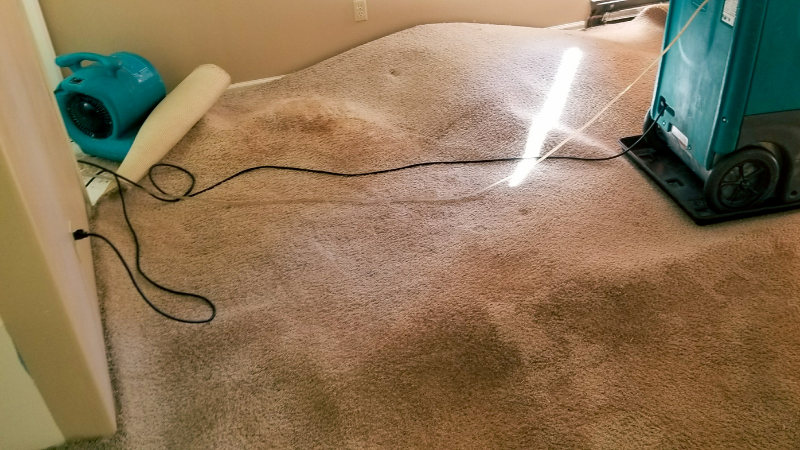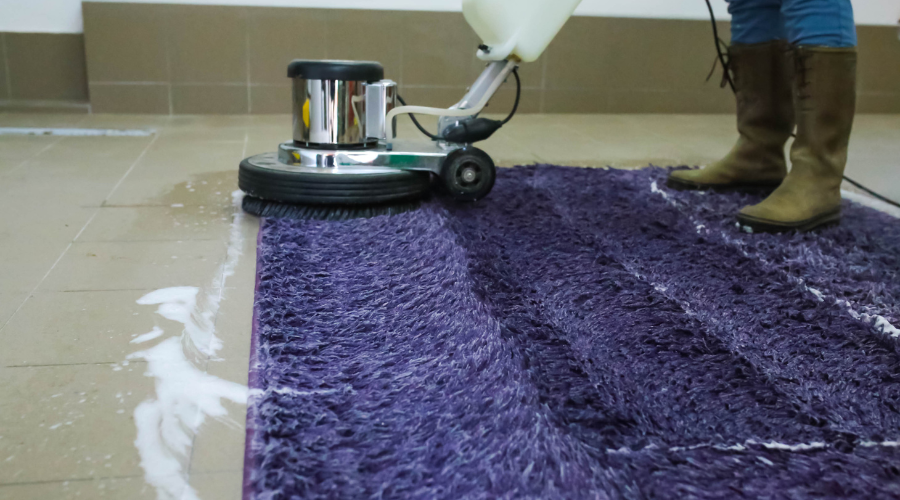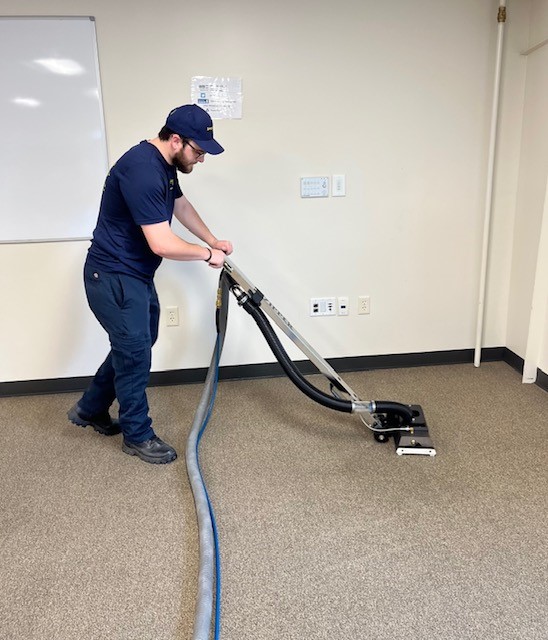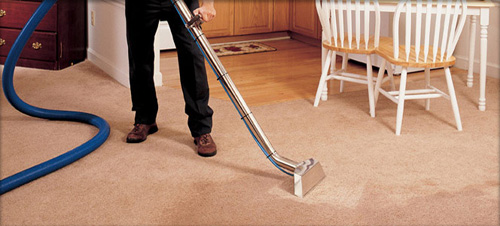Tips For Dealing With Flooded Carpets

Dealing with flooded carpets can be a daunting task, especially if you’re not sure where to start. From water extraction to dryingDrying is the process of removing moisture from materials, s... More and sanitizing, there are important steps to take to salvage your carpets and prevent moldMold is a type of fungus that grows in damp or humid conditi... More growth. Are you prepared to handle a flooded carpet emergency?
When carpeted rooms flood, the mess and damage can be overwhelming. Whether the flood was caused by natural disaster, leaking roof, or backed up sewer lines, standing water can quickly leadLead is a heavy metal that can be toxic to humans, especiall... More to moldMold is a type of fungus that grows in damp or humid conditi... More and bacterial growth. Protect your health and safety by dealing with flooded carpets immediately.
Safety First
When dealing with flooded carpets, safety should be your top priority. Standing water can contain harmful bacteria, moldMold is a type of fungus that grows in damp or humid conditi... More, and other contaminants that can pose serious health risks. Before attempting to address the flooded carpets, make sure to take the following safety precautions:
1. Turn off the power: If there is standing water in the affected area, it’s important to turn off the power to avoid any risk of electrocution. Be sure to also unplug any electrical devices in the area.
2. Wear protective gear: When dealing with flooded carpets, wear protective gear such as rubber gloves, boots, and a mask to protect yourself from any contaminants in the water.
3. Ventilate the area: Open windows and doors to allow for ventilationVentilation is the process of exchanging or circulating air ... More in the area. This will help to reduce the risk of moldMold is a type of fungus that grows in damp or humid conditi... More growth and improve air quality.
By prioritizing safety and taking the necessary precautions, you can effectively address flooded carpets in a safe and efficient manner.
Remove Excess Water
When dealing with flooded carpets, one of the first steps you need to take is to remove excess water as quickly as possible. The longer the water sits on your carpet, the more damage it can cause. Here are some tips for effectively removing excess water from your flooded carpet:
1. Use a wet/dry vacuum: A wet/dry vacuum is a great tool for quickly removing excess water from your carpet. Make sure to use the vacuum on the wet setting and go over the carpet multiple times to ensure you are removing as much water as possible.
2. Use towels or rags: If you don’t have access to a wet/dry vacuum, you can use towels or rags to soak up the water. Press down firmly on the carpet to help absorb the water, and continue using clean towels until they no longer come away damp.
3. Open windows and doors: Increasing airflow in the room can help speed up the dryingDrying is the process of removing moisture from materials, s... More process. Open windows and doors to allow fresh air to circulate and help dry out the carpet more quickly.
4. Use fans and dehumidifiers: In addition to opening windows and doors, you can also use fans and dehumidifiers to help dry out the carpet. Position fans around the room to help increase air circulation, and use a dehumidifierA dehumidifier is a device that removes excess moisture from... More to remove excess moisture from the air.
By quickly and effectively removing excess water from your flooded carpet, you can help prevent further damage and moldMold is a type of fungus that grows in damp or humid conditi... More growth. It’s important to act fast and take the necessary steps to dry out your carpet as soon as possible.

Restoring your wet carpet after a flood or water damage can be a big job, but hiring a professional instead of attempting it yourself can get the job done right.
Prevent Mold Growth
One important tip for dealing with flooded carpets is to prevent moldMold is a type of fungus that grows in damp or humid conditi... More growth. MoldMold is a type of fungus that grows in damp or humid conditi... More can start to grow within 24-48 hours of a flood, so it’s crucial to act quickly to prevent it from forming on your carpet.
Once you are done dryingDrying is the process of removing moisture from materials, s... More the excess water, sanitize the area to kill any moldMold is a type of fungus that grows in damp or humid conditi... More sporesSpores are microscopic reproductive units of fungi or mold t... More that may be present. You can use a mixture of water and vinegar or a commercial disinfectantA disinfectant is a chemical substance used to kill or inact... More to clean the carpet and surrounding surfaces. Be sure to focus on areas that are prone to moldMold is a type of fungus that grows in damp or humid conditi... More growth, such as corners and underneath furniture.
Lastly, continue to monitor the area for signs of moldMold is a type of fungus that grows in damp or humid conditi... More growth in the days following the flood. If you notice any musty odors or visible moldMold is a type of fungus that grows in damp or humid conditi... More, it’s important to address it immediately to prevent further damage to your carpet and potential health risks for you and your family.
By taking steps to prevent moldMold is a type of fungus that grows in damp or humid conditi... More growth, you can effectively deal with flooded carpets and protect your home from the damaging effects of moldMold is a type of fungus that grows in damp or humid conditi... More.
Flood Cleanup and Carpet Cleaning
 If there is standing water in your home or business, a flood cleanup crew will pump out the water and assess the overall damage. If the room has been under several inches of water for an extended period of time, there may be moldMold is a type of fungus that grows in damp or humid conditi... More damage. If this is the case, they may recommend replacing the carpet rather than trying to clean it.
If there is standing water in your home or business, a flood cleanup crew will pump out the water and assess the overall damage. If the room has been under several inches of water for an extended period of time, there may be moldMold is a type of fungus that grows in damp or humid conditi... More damage. If this is the case, they may recommend replacing the carpet rather than trying to clean it.
If the carpet is salvageable, or if the floodingFlooding is the overflow or accumulation of water in areas t... More has been minimal and you have already dried the area, a carpet cleaning company can restore your carpets to their original state. Before you sign a work order, the carpet cleaning company should give you a free onsite estimate. It is difficult to accurately estimate the costs of cleaning flooded carpets over the phone, because the technicians will need to see how much extensive cleaning and stain removal is needed.
Once the cleaning crew arrives, they will move any furniture out of the room and pre-treat the carpets. Next they will use steam cleaners that force hot water into the fibers to loosen dirt. Finally, they will rake the fibers to remove matting and restore the carpet to like-new condition.
Flood Cleanup Cost
Depending on the size of the room and the extent of the damage, flood cleanup can cost between $2,000-$7,000. Keep in mind that prices can vary from region to region, and from provider to provider. Be sure you understand everything that is included in the flood cleanup or carpet cleaning estimate, and do not be afraid to get several estimates before hiring a cleanup crew or carpet cleaning service.
Choosing a Flood Cleanup Provider

Your homeowners or business insurance agent is a good source for referrals for a water or flood cleanup provider. They encounter this type of situation often, and may know which providers are the most reliable and which to avoid.
If the flood damage is not serious enough to warrant filing an insurance claim, ask your neighbors for recommendations for a good carpet cleaning service. As for customer references from any company you get an estimate from. If you do not feel completely comfortable with a company when they arrive to give you an onsite estimate, hire another provider.













I hope I never have to use these tips but thank you for sharing very informative!
Good advice. As the climate continues to change, flooding will become more of an issue. It’s important to know what to do.
It is good to know that such a service is available … I am hoping I will never need this but good to have if I need to pass on the information. Thank you